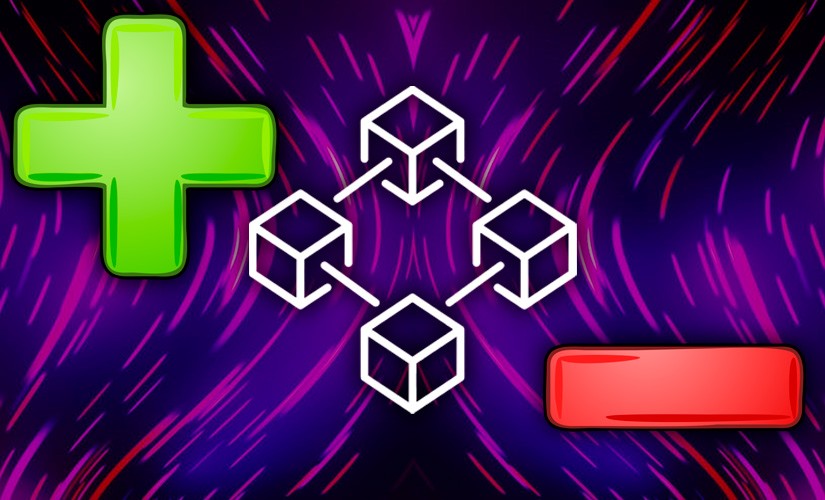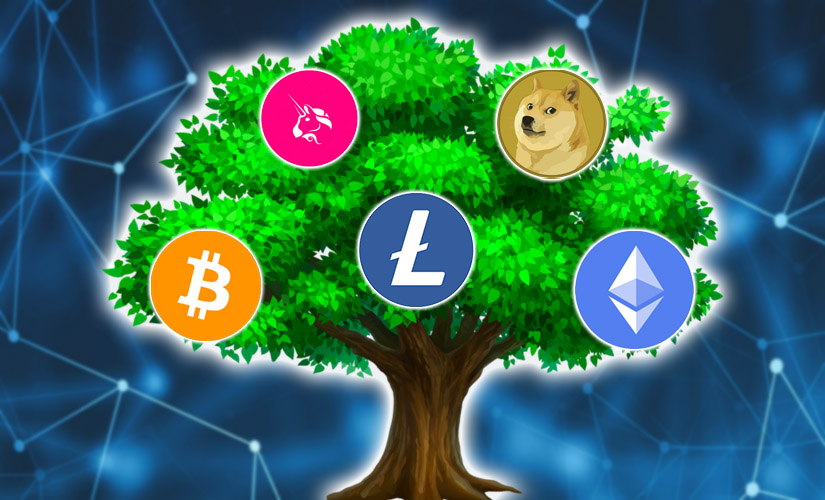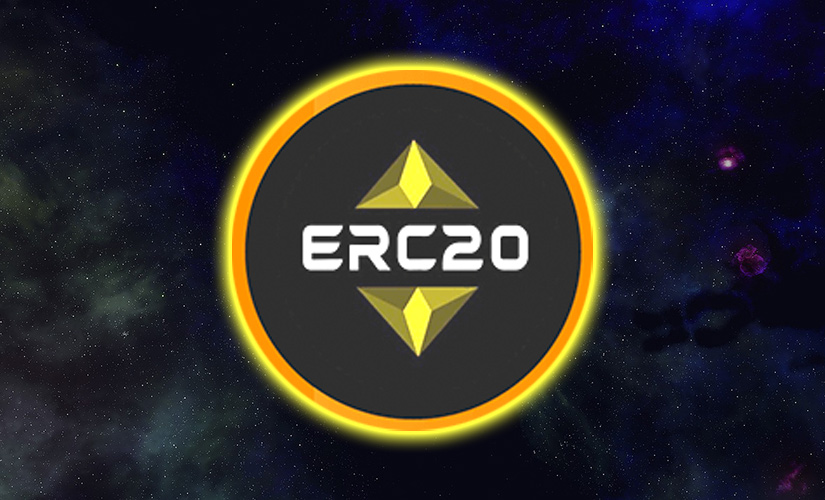The rapid growth of the cryptocurrency market has led the economy in new directions. Blockchain is a technology that offers an anonymous and secure system for sending data, including rights to things (houses, cars, money, land) and intangibles (intellectual property, patents). There are many uses for blockchain technology. And each sector of the economy applies it based on the challenges that need to be addressed.
Applications of blockchain
Distributed ledger technology has helped market participants solve problems on the way to creating economic relationships: reduce risks, distances, and cost. Transparency has become the standard. More trust between participants has emerged. According to the second global comparative study conducted by the research institute Cambridge Centre For Alternative Finance, the largest user of distributed ledger technology is the financial sector.
| Industry | Blockchain market share |
|---|---|
| Finance & Insurance | 43% |
| Cross-industry | 9% |
| Others | 12% |
| Accommodation and food services | 6% |
| Health care and social assistance | 6% |
| Retail trade | 4% |
| Mining, development and extraction | 4% |
| Transportation and storage | 4% |
| Arts, entertainment and recreation | 3% |
| Wholesale trade | 3% |
| Public administration | 3% |
| Real estate, renting and leasing | 3% |
Economics and Banking
The first industry of blockchain application. At the very beginning, developers assumed to use the technology exclusively in the field of finance because of such characteristics:
- Decentralization. The chain of blocks divides data between independent nodes, so there is no need for a third party to process and store information. Protection against information leakage is formed, and intermediaries will not control financial flows.
- 不変性。 Data that has entered the blockchain can no longer be corrected. Therefore, for financial transactions, distributed registries will be reliable sources of information.
- セキュリティ The technology of data transmission and storage in distributed networks is based on encryption. Only those who have access to the code will receive the information of interest. Encryption is conducted through private and public keys. The former is available to all users in the network and the latter is available only to the recipient of the transaction. All interested parties can view the transaction data, but the sent funds are available only to the owner of the private key. The financial system becomes more transparent and the confidential information of transaction participants is protected.
- Reducing the cost of services. The centralized nature of the financial sector is the cause of high costs associated with transaction servicing. These recurring costs increase the retail price of services. Smart contracts, which will eliminate intermediaries, automate accounting and remittances, reducing recurring costs.
- Reduced audit costs. Auditing financial statements is a long and expensive process due to the lack of transparency in companies’ accounting. Blockchain technology makes the audit process easier because unalterable transaction records can be audited to identify violations of legal requirements. A suspicious transaction is easier to trace with a distributed ledger.
- Manage risks faced by the financial sector: inability of borrowers to fulfill their obligations and asymmetric information (where some market participants know more than others). Peer-to-peer transactions will relieve service providers of the negatives associated with intermediaries. Smart contracts execute transactions quickly, and the immutability of the blockchain increases data reliability. The application of blockchain in economics and business will allow for more effective risk assessment and management.
Elections and electronic voting
Financial transactions and any other type of data are transmitted over the blockchain. This system is used to conduct voting. Elections through the submission of paper ballots to local governments are already obsolete. With the help of blockchain, this process can be moved online:
- Hackers will not access the database and will not affect the outcome of the election because the information will be stored on different nodes.
- Voters will be able to cast their vote without revealing their identity and political views.
- Officials will review the results knowing that each ID is associated with only one person. This eliminates voter fraud.
Medicine and health care
This system is also outdated. Receiving health care involves waiting and data limitations. As a result, inefficient patient outreach is conducted. There are many examples of blockchain being used in the healthcare sector due to the following reasons:
- Drug counterfeiting. Existing supply chain systems are unable to curb the spread of counterfeit drugs.
- Database maintenance also raises questions. Patient information is scattered across hospitals and departments, doctors cannot get reliable information about their health status on time. Medical reports contain errors. This results in patients not getting the right treatment.
- Misuse of medical information also raises questions. Patient data is sold to third-party companies and clinical reports are not fully published, leading to loss of information.
A distributed registry will help elements of the healthcare system to unify and share the necessary information. Data integrity will be continuously maintained at all levels. Information uploaded to the blockchain will be inaccessible to malicious actors. Only patients will enter new details when working with a doctor.
5020 $
新規ユーザーへの特典!
ByBitは暗号通貨取引に便利で安全な条件を提供し、低い手数料、高い流動性、市場分析のための最新ツールを提供します。スポット取引とレバレッジ取引をサポートし、直感的なインターフェースとチュートリアルで初心者からプロのトレーダーまでサポートします。
100 $ボーナスを獲得
新規ユーザー向け
暗号通貨の世界で迅速かつ安全にあなたの旅を開始することができます最大の暗号取引所。このプラットフォームは、何百もの人気資産、低い手数料、取引と投資のための高度なツールを提供しています。簡単な登録、高速取引、信頼性の高い資金保護により、Binanceはあらゆるレベルのトレーダーにとって素晴らしい選択肢となっています!
Blockchain also solves the problem of drug counterfeiting as it allows supply chain data to be transferred to a distributed immutable registry.
Digital Identity
Each subject is characterized by a specific set of personal data: date of birth, citizenship, degrees, business licenses, and more. In the physical world, all of these metrics are realized in the form of credentials and certificates that holders store in a secure location.
Decentralized Identifiers (DIDs) create peer-to-peer connections between two participants. Their distributed nature makes credentials always available for verification. Each party – individual or organization – can create as many DIDs as they need. Applying them to different digital relationships will prevent data correlation.
Decentralized identifiers do not depend on centralized registries, authorities, or credential providers. When an institution issues verifiable credentials to a user, it attaches its public DID to them. The same decentralized identifier is stored in the distributed registry as an immutable record. When the user needs to verify the authenticity of the data, he can look up the DID in the blockchain to see who issued it. He does not need to contact the issuer directly, as the distributed registry is easily verifiable.
There are three parties involved in decentralized identification: certificate holders, issuers, and verifiers.
Certificates will be issued by the government or commercial organizations, confirming the validity of the identity. And the credential holder will store this information in their personal wallet and use it to identify their identity to a third party (verifier).
Referral programs
Multi-level marketing is a million dollar industry and an effective strategy to promote a company’s products. 80% of brands operate referral programs and blockchain is used for the following reasons:
- Cryptocurrencies simplify payment processes.
- Products based on it are easy to identify.
- Smart contracts provide accountability and reduce fraud.
- There is no need to track metrics because these processes are automated.
Copyright protection
Blockchain immutability keeps information about ownership of intellectual property. This is essential for owners because it prevents possible claims from third parties to copyrighted items. If litigation arises, the copyright owner is free to prove the legitimacy of copyright ownership.
Distributed registry technology is also used to register processes related to obtaining patents or trademarks. It allows data to be located nationally and internationally. Smart contracts are also used to grant licenses or accrue royalties.
Taxation
Demand for reliable data from regulatory authorities is increasing. Distributed ledger technology eliminates the shortcomings of the tax system, which suffers from limited access to information. Blockchain is used to collect reliable data that is verified by network participants, executive authorities. Smart contracts can be used in the payment of taxes for financial transactions: VAT, other fixed charges, as well as insurance premiums.
Payment instrument
Blockchain technology offers a secure, fast way to settle payments without the involvement of a third party.
Companies are passing trillions of dollars through an outdated, slow payment system with high fees. Cryptocurrencies created on blockchains are available to everyone. BTC transactions take an average of 10-60 minutes to settle. And while this system is not perfectly implemented, it is much faster than the average bank transfer processing time of 3 days. And because of the decentralized nature of cryptocurrencies, the government and regulators do not control settlement transactions.
The volume of transfers with cryptocurrencies is increasing every year. The Ethereum network was the first to make $1 trillion worth of transactions in 2020.
Forecasting
Developing an effective system for determining demand prospects is a task that has not yet found an unambiguous solution. Forecasting is based on quality analytics, and this is only possible if you have access to information from reliable sources. When each business in the supply chain processes data differently, errors occur, which greatly reduces efficiency. Manufacturers are turning to blockchain to close these gaps and ensure the validity of information.
The solution is to standardize the collection, analysis and sharing of data across the supply chain. Information is recorded in a distributed registry and cannot be altered or tampered with. The data registry is made available to every member of the supply chain. This allows parties to control the quality of information about sales, inventory, production and other processes.
不動産
Apartments, parking lots, buildings – transactions involving these properties have long been done on blockchain. Realtors are using smart contracts to make real estate transactions and investments transparent and efficient. The use of blockchain technology speeds up contract processes and reduces costs.
As the daily number of real estate transactions is high, a common database of rentals and purchases is necessary for every market participant. Moving traditional information storage to blockchain creates a transparent accounting system where brokers and agents will see the history of property transactions.
Food industry
The industry’s chain of production involves farmers, shipping companies, wholesalers, retailers, and distributors. A simplified example of digitizing the food supply chain on blockchain would look like this: every action performed by the participants is recorded on the blockchain. The information is then validated by business partners, forming a consensus between the nodes. Once verified, the block is added to the chain. Food production involves different actors, so data will be recorded at each step:
- Supplier. Data on crops used, pesticides and fertilizers, machinery.
- Producer. Information on the farming practices used. Additional data on the process of growing crops, weather conditions or animals and their welfare.
- Processing. Information on factory and equipment, production methods, lot numbers, financial transactions that occur with suppliers and distributors.
- Distribution. Shipping information, routes, storage conditions (e.g., temperature, humidity), travel time for each method of transportation. All transactions between distributors and final recipients are recorded in a distributed register.
- Retailer. Information about each product, its current quality and quantity. Expiration date, shelf life, storage conditions and time on shelf are listed in the chain.
- Consumers of the product can use an internet-connected cell phone or web application to scan the QR code associated with the food product, viewing information about the chain of production.
教育
The technology has also found application in the organization of educational processes:
- It helps in authenticating issued diplomas. Technology is also well applicable in accreditation of educational institutions, resulting in reduced fraud. There are many known precedents of job seekers using fake degrees while applying for jobs. This leads to the hiring of poorly qualified personnel. A distributed registry ensures consistent and transparent accounting of all assigned specialties and supporting documents.
- Protection against copyright infringement. In the academic world, plagiarism is a problem. Blockchain will help authors prevent their works from being illegally distributed online. The technology guarantees secure storage of information through encryption. Owners of learning materials will be able to track, verify and authorize access to use their digital content.
- Improving learning platforms. Universities can develop user-friendly educational systems and projects.
Aviation
The airplane transportation industry is also benefiting from a distributed registry:
- Baggage tracking. Blockchains contain data on the location and status of shipments. The technology provides transparency of movements, making it easy for interested parties to find their luggage at any time.
- Identity Confirmation. Biometric data, required documents and tickets will be stored in a distributed registry. Passengers simply enter the airport using a verification code, and check in next without queues.
- Overbooking. Smart contracts will automate the ticketing system and limit the manual addition of flight documents.
- Aircraft maintenance. Aircraft can move from one owner to another several times during their lifecycle. Verifying aircraft information can be a complex and time-consuming process. For this reason, an immutable record that contains an aircraft’s maintenance history in digital form can be of value to stakeholders.
- Automated payments. Smart contract technology can be applied to company transactions such as invoicing counterparties, maintaining a loyalty program, and paying airport fees and taxes.
Jurisprudence
The legal basis of blockchain has been hotly debated among government officials in recent years. However, lawyers are already using the technology to solve their professional problems:
- Blockchain democratizes access to the justice system, reducing the complexity of legal processes for participants and reducing legal costs.
- Standardization of blockchain-based contracts will allow manual tasks to be performed automatically and reduce time spent drafting and amending documents, as well as lowering the cost of legal services. Reduced costs will increase overall demand and ensure affordability.
- Legal documents are often the target of hackers looking to profit from valuable confidential information held by lawyers. Instead of sending sensitive data via email, lawyers can store the information in a decentralized distributed registry, ensuring security.
- Forgery or alteration of documents can also be tracked thanks to the blockchain.
The application of blockchain will optimize, redesign, and automate the legal industry, as well as eliminate mediation, and ensure that many processes are carried out securely.
Insurance
Blockchain is helping the industry to radically transform operations by enabling fast data exchange and transparency for all parties:
- Blockchain technology improves coordination between insurers in the fight against fraud. Storing claims information in a shared ledger will help companies collaborate and identify suspicious behavior in the ecosystem.
- Life Insurance. Smart contract technology will help remove the burden of filing a claim on the death of a family member by replacing the manual process with an automated system built on a public ledger.
- Property and casualty insurance. Blockchain technology can codify policies and automate claims processing through smart contracts. If paper contracts are translated into code, processing customer claims and calculating insurance liabilities will be done without human intervention.
- Healthcare. The system can store every patient record. Therefore, you will not have to gather information from databases to work on insurance claims.
- Renewal of contracts using smart contracts. Blockchain technology can simplify the flow of information and payments between insurers and policyholders.
Energy sector
Companies looking to implement blockchain in the electricity distribution system are focused on including end users in the supply chain. Distributed ledger technologies combined with IoT (internet of things) devices allow consumers to trade and buy energy directly from producers rather than retailers.
A peer-to-peer market is a network in which some participants trade excess energy and others buy it. This process reduces the influence and control of central authorities and wholesalers.
Database management and document management
Businesses have come a long way from the traditional cumbersome paper document system to flexible and reliable digital alternatives. Over the past decade, cloud-based centralized storage technology has surpassed local physical devices: hard drives or servers. Blockchain allows files to be contained without the involvement of centralized data storage, while ensuring privacy and security.
The technology utilizes a distributed network in which all nodes store small encrypted pieces of information. Each block is endowed with a unique ハッシュ and distributed across multiple computers. This process is called segmentation. If attackers break into the storage, they get encrypted blocks containing only a portion of the data, not the entire files.
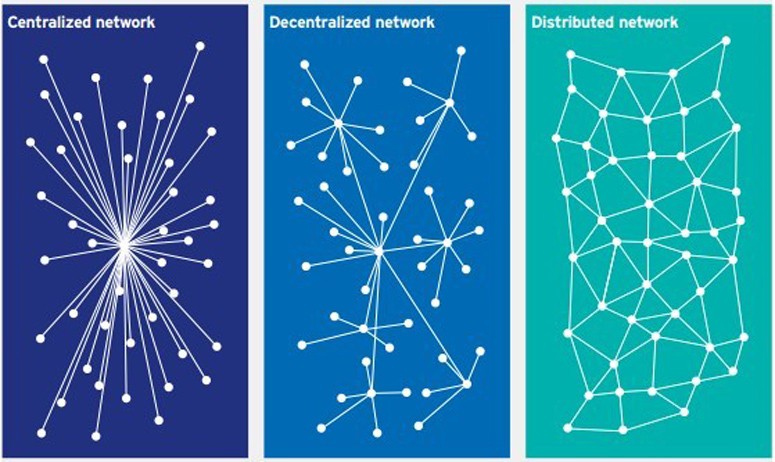
物流
There are several uses of blockchain in managing the flow of goods:
- The origin or chronology of changes in information about the transfer of ownership, storage, or location of an object. It is as if each item shipped has a digital “passport” that authenticates its origin and route of travel.
- Invoices and payments. These processes are often accompanied by manual work and paperwork, which each logistics company handles differently. With blockchain, digitized records can be stored and exchanged, and smart contracts can be created that automatically process invoices and payments.
- Logistics Marketplace. Blockchain enables seamless and integrated communication in complex supply chains. It can be used to create platforms where logistics service providers offer free resources of their trucks or ships in real time.
Ridesharing
Ride-sharing and carpooling are very popular in major cities suffering from traffic jams and congestion. However, this concept can be improved by incorporating blockchain into ridesharing services:
- Peer-to-peer ridesharing. The cab booking process requires intermediaries: operators, payment systems. All this leads to a lack of transparency. Blockchain allows for the rental of vehicles, linking the 2 sides of the transaction directly. This way users will not depend on intermediaries.
- 顧客の識別。 Due to the availability of data on the public platform, transparent verification of the driver and passenger is ensured. The blockchain prevents the theft of personal information as it is protected by strong cryptographic keys.
- Contracts are signed and payments are made directly between the travel parties involved.
- Data Security. Information is stored in a distributed registry that can only be accessed through decentralized applications. Thus, there will be no single database that can be hacked.
Manufacturing
From raw material sources to the finished product, blockchain can increase transparency and trust at every stage of production. Pain points that the technology solves:
- Monitoring the supply chain, including complex cross-sequences where delays and constraints affect production and profitability.
- Material provenance and counterfeit detection. Reducing the output of counterfeit products and reducing the impact of piracy.
- Engineering products of long production runs and high complexity, for which delays in communicating technical specifications or part substitutions increase rework or affect lead time (e.g., airplane release).
- Identity Management. When it is important to know who is taking action and what their credentials are, including lawyers, auditors, engineers and technicians.
- Monitoring of assets and complex equipment, as well as its movement and logistics.
- Quality assurance available for all products.
- Compliance with regulatory requirements.
Gemstone turnover
This generalized blockchain example is used to illustrate how information about the journey of an individual gemstone can be documented – from mining, cutting, and onward to retail sale to the end consumer.
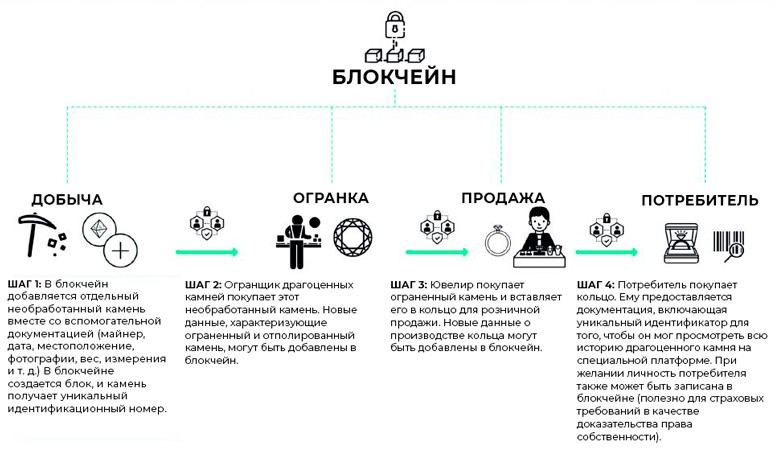
Philanthropy
Organizations have to work with the public, government, press and other companies to achieve their goals. Blockchain technology helps to organize such processes:
- Automation. Smart contracts perform common administrative tasks, reducing the burden on staff.
- Secure information sharing. Data duplication and inaccuracies that occur when organizations interact are reduced. Utilizing one distributed registry helps you get real-time information.
- Tracking individual donations. Blockchain creates a fully controlled chain of donations. The philanthropist can see who has been helped by the money.
- Transnational donations are possible.
- Precisely targeted aid – helping exactly the people who need it by verifying their identity through a distributed registry.
- Providing emergency assistance. Collaboration across agencies, geographic and political boundaries for coordinated and rapid delivery of emergency support.
- Donor anonymity. Digital wallets enable voluntary donations, eliminating the awkward situations of large-scale charitable giving.
Entertainment industry
Blockchain has the potential to transform the media and leisure markets, allowing participants to benefit from security and transparency.
Today’s streaming services are closed systems that aim to protect content. Users are forced to view or listen to media products only through regulated players and apps.
However, blockchain allows content to be consumed without the proprietary audio or video players of a particular platform. If a consumer has credentials, they can apply any software to listen to music or watch their favorite shows.
Thanks to blockchain, users can even consume content in installments (reading a single article or watching a particular TV show) by making micropayments rather than paying for a subscription. Such a pricing model is usually inefficient when implemented, but it can be automated and cost-effective thanks to the blockchain.
Distribution of multimedia files
Illegal peer-to-peer sharing of music, movies, and other copyrighted items is commonplace. However, content sharing can become a legally correct practice when blockchain is implemented. When consumers buy media files stored on the blockchain and then share them with a friend, owners can monitor the process and charge a distribution fee. This will generate an additional revenue stream for creators and provide better transparency into the use of copyrighted assets. In doing so, objectives such as:
- Elimination of intermediaries. The decentralized structure of blockchain allows content creators (musicians, writers) to offer their works directly to audiences, bypassing traditional distribution channels and keeping a share of revenues for themselves.
- Royalty distribution. Blockchain provides transparency in the process of collecting license fees. For example, every time a song is streamed online or played in the background of a TV show, the distributor must compensate the copyright holder, but sometimes there are disputes over the accuracy and amount of royalties. Smart contracts built on blockchain and attached to a specific piece of music will increase accuracy, speed and trust in the process by automatically honoring the terms of the contract between eligible parties.
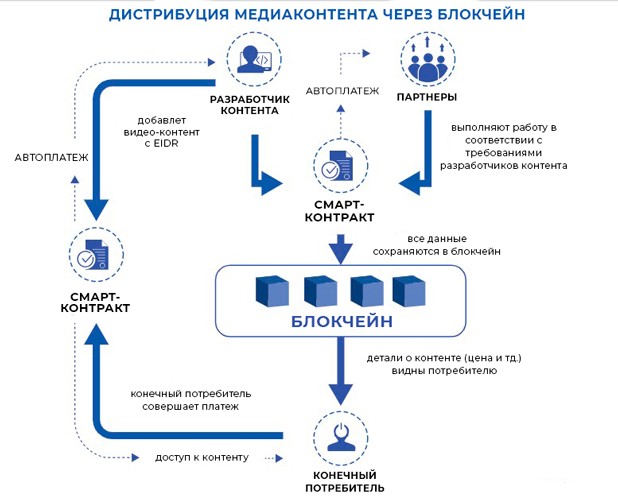
Confidential messaging
Everyone is already used to トークン (coins) being transferred via transactions on the blockchain. But there is a special type of data transfer via blockchain that allows you to send private messages. To do this, you need to go through several steps:
- Encrypt the text of the message.
- Place the message in a transaction.
- Sign the transaction.
- Send the transaction to the node.
- The distributed system authenticates the message.
- If everything is OK, the transaction is included in the next block.
- The recipient accepts the message and decrypts it.
Steps 1-3, 7 are performed locally, steps 5-6 are implemented on the network nodes. In this method of transmission, the message becomes a transaction.
Investments and exchanges
The concept of blockchain was first introduced by Bitcoin. The uniqueness of this peer-to-peer electronic monetary system was to solve the problem of double-spending, where the same asset could be traded more than once. For years, companies have been working to simplify the process of trading stocks, and now new blockchain-focused startups are looking to automate and secure it.
Project Chain, which was acquired by the Stellar project in 2018, helped integrate distributed ledger technology and connect the Nasdaq stock exchange and Citi’s banking infrastructure. More recently, Nasdaq formed a collaboration with financial technology company R3. The goal is to create a platform utilizing Corda’s enterprise blockchain software solution that financial institutions can apply in managing their own digital asset markets.
The crowdfunding industry has also begun to get rid of intermediaries, allowing funders and private investors to directly fund entrepreneurs through the application of blockchain. Initial Coin Offerings (ICOs), in which companies sell tokens backed by cryptocurrency, or Initial Public Offerings (IPOs) are another example of blockchain-based crowdfunding.
Surprisingly, in cryptocurrency exchange trading, some of the most successful blockchain companies are centralized intermediaries. And new trading platforms have already moved fully onto blockchain. DEX exchanges operate without a third-party exchange center. And even CEXs like Binance and Coinbase have made moves towards decentralized exchanges (Binance DEX).
スマートコントラクト
The application of blockchain is not just limited to the transfer of digital tokens. Smart contracts – programs that add layers of information to transactions performed on the blockchain – are actively used. These algorithms perform complex transactions than a simple exchange of digital tokens.
The Bitcoin blockchain does not support smart contracts, it is only used for normal peer-to-peer cryptocurrency transfers. The second most capitalized blockchain Ethereum has the functionality to deploy smart contracts. However, the capabilities provided by the network are not perfect. This is due to the fact that Ethereum currently uses single-layer smart contracts, and all information regarding the transaction (buyer and seller identities, execution time, value) is mixed up. Because of this, transactions on the network become expensive and slow to execute. Such a blockchain is called a Tier 1 solution.
The next set of features aimed at scalability of the blockchain is Tier 2. When the load on the network is reduced by grouping similar transactions and reducing the total number of transactions.
DDoS attack prevention
Distributed Denial of Service occurs when multiple devices connected to the internet simultaneously and repeatedly send traffic to the victim’s server to overwhelm it.
The use of blockchain enables the creation of peer-to-peer IoT networks. Devices no longer need to trust each other, so there is no centralized single point of failure. Blockchain makes transactions secure through cryptographic operation of nodes. This removes the importance of a central authority and also makes authentication of devices to interact with other users unnecessary.
Blockchain application industries in Russia
The Russian government supports the introduction of innovations based on distributed networks. The financial industry is actively applying DLT. In Russia, DLT-based projects are implemented by large financial institutions and banks, unlike, for example, non-banks and other fintech companies in Europe and the United States.
The decisive factor is the reduction of costs for traditional business processes. The Bank of Russia supports the creation of DLT-based financial services with other participants (e.g. Masterchain) and is considering project options: e-mortgage, digital letters of credit and bank guarantees. The Central Bank has been active in financial technology.
The National Securities Depository of Russia hosted a platform for electronic voting of shareholders on blockchain. Russian registrars use similar services for their work. DLT is also being used in the public sector. The Moscow government conducted blockchain-based voting during the city’s parliamentary and municipal elections. Another example of blockchain application is a service for state registration of real estate transactions. There are options for using DLT in other sectors: education, scientific research, transportation logistics and others.
Blockchain implementation challenges
The American Productivity and Quality Center (APQC), based on a survey conducted in 2020, identified 5 obstacles to integrating blockchain into economic activity:
- Lack of diffusion. APQC found that only 29% of organizations are implementing blockchain or have fully deployed it. Without widespread adoption, the efficiency and scalability of the technology will remain limited.
- Lack of skills. The use of blockchain still requires more specialists to implement the technology to achieve the relevant goals.
- User distrust. This problem needs to be addressed in two ways: organizations believe the technology itself is insecure, and they also do not trust other parties on the blockchain.
- Lack of financial resources. Blockchain implementation will require significant investment.
- Network compatibility. A lot of organizations are starting to implement blockchains, and their own systems are emerging with personal settings: governance rules, versions, consensus models, and more. These individual blockchains will not work together. There is no universal standard that allows networks to interact with each other.
ブロックチェーン技術の未来
The adoption of distributed ledger systems will bring major changes and opportunities to industries. But not everyone agrees on what role blockchain should play in the future. Therefore, predictions about the technology’s ability are mixed.
A recent report by analyst firm Gartner Trend Insight Report made the following prediction:
- By 2022, only 10% of enterprises will achieve radical transformation using blockchain.
- By that same year, at least one innovative business built on the technology will be worth $10 billion.
- By 2026, the value-added of businesses adopting blockchain will grow to ~$360 billion, and by 2030, it will grow to $3.1 trillion.

Blockchain is used to prevent hacking, secure data, and allow participants to authenticate a file.
Blockchains will definitely change the technology and IT sector in the coming years, similar to what the internet did in the 90s and early 2000s.
よくある質問
🤔 Is blockchain difficult to implement?
The technology is helping to solve problems that were previously considered unrealizable. Therefore, it is more often difficult for companies to organize a project on blockchain because of the number of unexplored possibilities.
❓ Does blockchain technology have disadvantages?
These include scalability, high power consumption, immutability of data, and incomplete security. It is the responsibility of the user to store private keys.
❔ Can the blockchain be hacked?
Since the network is constantly checked by the participants, attacks by hackers are unlikely.
❗ Are decentralized protocols and blockchain the same thing?
In computing, protocols are the rules that determine the order of transmission between computer systems. These are the main components of blockchain technologies.
❕ What is decentralization?
Means the transfer of control and decision-making from a centralized entity (an individual, organization, or group) to a distributed network.
テキストに間違いはありませんか?マウスでハイライトして Ctrl + 入る。
著者 サイフェデ・アムス暗号通貨経済学の専門家。


